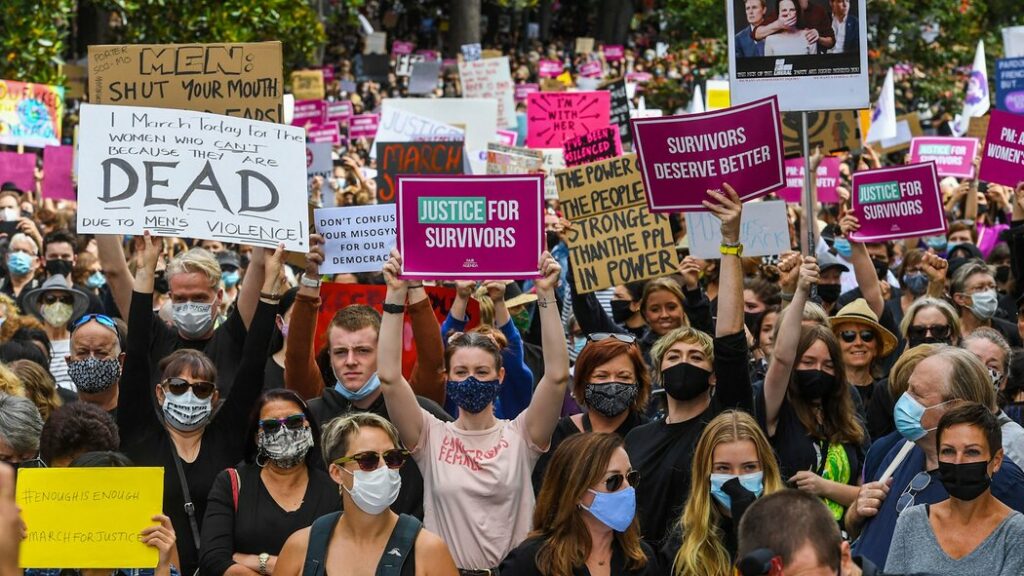By Salvatore Scevola

In democratic systems of government people protests of all kinds are both an important means of political discourse and a contentious manifestation of social discord. Unusually in these modern statute-based times, it is the common law right to assembly that provides the foundational legal basis of what is commonly called the right to protest. The origins of the common law right to assembly have been traced back 800 years to the signing of the Magna Carta.[1]
The common law right to assembly has been expressly recognised by Australian courts, including the High Court of Australia and the Supreme Court of NSW. It is further protected by the Australian Constitution under the implied freedom of political communication. Workers have used this right in solidarity with one another to bring about many important and necessary strikes in NSW.
Strike action, is a work stoppage caused by the mass refusal of employees to work. A strike usually takes place in response to employee grievances, particularly over pay and working conditions. Strikes became common during the Industrial Revolution, when mass labor became important in factories and mines. In most countries, strike actions were quickly made illegal, as factory owners had far more power than workers. Most Western countries partially legalized striking in the late 19th or early 20th centuries, Australia is one such country.[2]
In the twentieth century the peculiar nature of Australian unionism became more pronounced as arrangements for the compulsory conciliation and arbitration of industrial disputes were adopted by the Commonwealth and most states. Bolstered by this regulatory system, national union density never once fell below 40 per cent between 1913 and 1992[3].
The Great Strike of 1917, was Australia’s biggest. It lasted more than two months, from August 2 until the last workers drifted back to work on October 15, but the impact of the strike lasted a lot longer. The strike involved more than 100,000 workers — at a time when the total population of Australia was less than 5 million. It was one of the most important industrial and political confrontations in Australian history. It shook the country to the core, and prompted cries of “revolution” from both sides of the struggle.[4]
The 1949 Australian coal strike was also the first time that Australian military forces were used during peacetime to break a trade union strike.[5]
The right to protest peacefully is a defining feature of liberal democracy, a system of government characterised by the tolerance of dissenting minority opinion. Protests can be on issues as diverse as the environmental impact of mining[6] or the influence of Chinese investors on Sydney property prices.[7]
A protest is, quintessentially, an expression of opposition, disapproval or discontent. A physical manifestation of social discord, protests are inherently polarising. They can be viewed, depending on the social standpoint of the observer, as an integral part of a democratic process; a threat to social order; a nuisance to be tolerated; or an impediment to business and economic growth.[8] Employee strikes that disrupt the workplace and by default society, have a place in any self-respecting democracy.
The right to peaceful assembly is recognised by international law. Article 21 of the International Covenant of the Civil and Political Rights (ICCPR) states:
“The right of peaceful assembly shall be recognized. No restrictions may be placed on the exercise of this right other than those imposed in conformity with the law and which are necessary in a democratic society in the interests of national security or public safety, public order … the protection of public health or morals or the protection of the rights and freedoms of others.”[9]
Ultimately, in the absence of Commonwealth legislation incorporating Article 21 into domestic law, while the right to protest at international law may have important symbolic significance, its practical effect is limited. In considering the limit to the protection of protests afforded by the implied freedom of political communication, Brennan CJ said that a law which simply denied people an opportunity to protest “would be as offensive to the constitutionally implied freedom as a law which banned political speechmaking.”[10]
Up until 2009 the State government was responsible for Industrial Relations in the state on NSW, after that time the Commonwealth usurped the industrial relations powers under s 51 (xx) of the Constitution , the Corporations power . Now, the Fair Work Act (Cth) (FWA), in particular Part 3.3 of the Act deals with the ‘rights’ to (lawful) industrial action and they are heavily predicated on the action being “approved” by the Fair Work Commission (FWC). Under s 423 the FWC must be satisfied that the protected action has been engaged in for a protracted period, and is unlikely to be resolved in the foreseeable future. Section 424 deals with the different situation where the protected industrial action has threatened, or is threatening to:
–endanger the life, the personal safety or health, of the population or part of it; or
–cause significant damage to the Australian economy or an important part of it.
Very recently the Fair Work Commission suspended the proposed 24-hour strike scheduled for Sydney and NSW train drivers because it was “threatening to endanger the welfare of part of the population” and would “cause significant damage to the Australian economy or an important part of it.” As a result of this and other decisions Sally McManus (ACTU President) said recently, it means “the basic right to strike in Australia is very nearly dead”[11] and the writer tends to agree.
For example, the NSW Teachers Federation made a major break with the past in 1968, its 50th anniversary, when the first state-wide strike was called over the appalling conditions in which teachers were working. The strike was an overwhelming success – the vast majority of members stopped work and the demonstration outside Parliament House is still remembered.[12]
At the recent 2016 annual LNP conference in Queensland, while referring to the capacity of industrial disputes PM Turnbull said strikes act “as a handbrake on economic growth”, he urged the Opposition Leader Bill Shorten to “meet us in the sensible centre” – a point that from Turnbull’s point of view also includes the Australian Building and Construction Commission and the Registered Organisation Commission – two organisations implicitly established to curtail union power.[13]
The right to strike on political issues is a controversial, contested industrial relations and labour law issue. Governments and employers use labour law against the political protests of striking unionists. Controlling industrial action by sanctions (almost) extinguishes the right to strike. Workers and unions raise issues of unfairness arguing an imbalance between the interests of labour and capital.
[1] Protests and the law in NSW, Briefing Paper for the NSW Parliament by Briefing Paper No 7/2015
by Tom Gotsis, Executive Summary page 3
[2] https://en.wikipedia.org/wiki/Strike_action
[3] The Rise and Decline of Australian Unionism: A History of Industrial Labour from the 1820s to 2010
Bradley Bowden, https://research-repository.griffith.edu.au/bitstream/handle/10072/40801/69891_1.pdf at 51
[4] https://www.greenleft.org.au/content/meaning-great-strike-1917 Accessed 1/3/2018
[5] https://en.wikipedia.org/wiki/1949_Australian_coal_strike Accessed 2/3/2018
[6] For example: J Buckingham, Gloucester Community Protest, NSW Parliament, Legislative Council, Hansard, 4 November 2014, p 1,948; J Buckingham, Maules Creek Coal Mine, NSW Parliament, Legislative Council, 18 September 2014, p 816; D Shoebridge, Bentley Blockade, NSW Parliament, Legislative Council, 15 May 2014, p 28,889.
[7] D Munoz, Race Hate Flyers Distributed in Sydney Spark Rally Outside Chinese Consulate, Getty Images, 31 May 2015; S Anderson, “Redneck” anti-foreign flyers distributed ahead of Sydney protest, 29 May 2015, SBS World News.
[8] R Douglas, Dealing with Demonstrations: The Law of Public Protest and its Enforcement, 2004, The Federation Press, Sydney, Ch 1.
[9] Entered in to force on 23 March 1976: Article 49. Signed by Australia in 1972 and ratified in 1980: United Nations, Status of Ratification Interactive Dashboard.
[10] Levy v The State of Victoria (1997) 189 CLR 579 at 595 per Brennan CJ.
[11] https://www.theguardian.com/business/grogonomics/2018/jan/28/expect-a-big-fight-on-industrial-relations-this-year-as-low-wage-growth-fuels-discontent Accessed 3/3/2018
[12] https://www.nswtf.org.au/about/history.html. Accessed 4/3/2018
[13] https://www.theguardian.com/business/grogonomics/2018/jan/28/expect-a-big-fight-on-industrial-relations-this-year-as-low-wage-growth-fuels-discontent Accessed 28/2/2018
